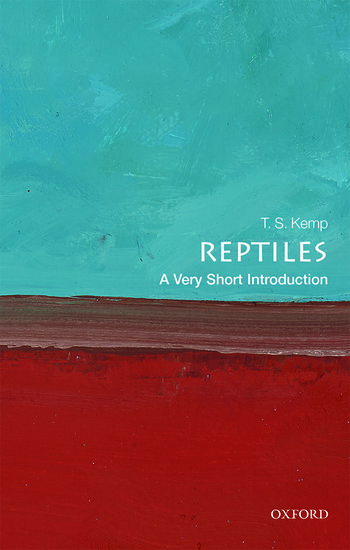Home >
A Very Short Introduction >
Reptiles (Biology)
A Very Short Introduction | Biology
Reptiles
ISBN: 9780198806417
Series: A Very Short Introduction
Reptiles (Biology)
A Very Short Introduction Reptiles (Biology) Media > Books > Non-Fiction > Education Books Expect Delays of Up to 4 Weeks| Order Below |
ISBN
9780198806417 (10-digit ISBN: 0198806418)
- Description
- Key Features
- Series Description
- Table of Contents
- Introduces the extraordinary diversity of reptiles which have walked the Earth, from the dinosaurs of the past to modern day living species
- Discusses the evolutionary history of reptiles, and the individual adaptions which have fitted them for their unique ways of life
- Analyses individual groups such as snakes, lizards, crocodiles and turtles and explores their biology and behaviour
- Contemplates threats to modern day reptiles such as over-exploitation, habitat destruction, and climate change
For millions of years reptiles have walked, crawled, and slithered over the face of our Earth. From the mighty dinosaurs who dominated the land, the pterosaurs who took to the air, and the marine adapted ichthyosaurs, to the living reptiles today such as the lizards, snakes, crocodiles, and turtles, plus the single species of tuatara in New Zealand, reptiles have come in all shapes and sizes.
In this Very Short Introduction Tom Kemp discusses the adaptations reptiles made to first leave the sea and colonise the land in dry conditions, such as their waterproof skin, their ability to expel almost dry waste products, their efficient use of external heat for maintaining their body temperature, and the amniotic egg that is laid and develops on dry land. Considering the different living groups of reptiles today, Kemp then describes how their respective bodies are adapted for their different ways of life, from snake feeding patterns to the way crocodiles breathe. Finally, Kemp assesses the threat of extinction to reptile species due to over-exploitation, habitat destruction, and climate change, and considers what can be done.
Oxford's Very Short Introductions series offers concise and original introductions to a wide range of subjects--from Islam to Sociology, Politics to Classics, Literary Theory to History, and Archaeology to the Bible.
Not simply a textbook of definitions, each volume in this series provides trenchant and provocative--yet always balanced and complete--discussions of the central issues in a given discipline or field. Every Very Short Introduction gives a readable evolution of the subject in question, demonstrating how the subject has developed and how it has influenced society. Eventually, the series will encompass every major academic discipline, offering all students an accessible and abundant reference library.
Whatever the area of study that one deems important or appealing, whatever the topic that fascinates the general reader, the Very Short Introductions series has a handy and affordable guide that will likely prove indispensable.
Please note: As this series is not ELT material, these titles are not subject to discount.
Introduction
1: What is a reptile?
2: The history of reptiles
3: Lizards
4: Snakes
5: Crocodiles
6: Turtles
7: Reptile conservation
Further reading
Index
For millions of years reptiles have walked, crawled, and slithered over the face of our Earth. From the mighty dinosaurs who dominated the land, the pterosaurs who took to the air, and the marine adapted ichthyosaurs, to the living reptiles today such as the lizards, snakes, crocodiles, and turtles, plus the single species of tuatara in New Zealand, reptiles have come in all shapes and sizes.
In this Very Short Introduction Tom Kemp discusses the adaptations reptiles made to first leave the sea and colonise the land in dry conditions, such as their waterproof skin, their ability to expel almost dry waste products, their efficient use of external heat for maintaining their body temperature, and the amniotic egg that is laid and develops on dry land. Considering the different living groups of reptiles today, Kemp then describes how their respective bodies are adapted for their different ways of life, from snake feeding patterns to the way crocodiles breathe. Finally, Kemp assesses the threat of extinction to reptile species due to over-exploitation, habitat destruction, and climate change, and considers what can be done.
Key Features
- Introduces the extraordinary diversity of reptiles which have walked the Earth, from the dinosaurs of the past to modern day living species
- Discusses the evolutionary history of reptiles, and the individual adaptions which have fitted them for their unique ways of life
- Analyses individual groups such as snakes, lizards, crocodiles and turtles and explores their biology and behaviour
- Contemplates threats to modern day reptiles such as over-exploitation, habitat destruction, and climate change
Series Description
Oxford's Very Short Introductions series offers concise and original introductions to a wide range of subjects--from Islam to Sociology, Politics to Classics, Literary Theory to History, and Archaeology to the Bible.
Not simply a textbook of definitions, each volume in this series provides trenchant and provocative--yet always balanced and complete--discussions of the central issues in a given discipline or field. Every Very Short Introduction gives a readable evolution of the subject in question, demonstrating how the subject has developed and how it has influenced society. Eventually, the series will encompass every major academic discipline, offering all students an accessible and abundant reference library.
Whatever the area of study that one deems important or appealing, whatever the topic that fascinates the general reader, the Very Short Introductions series has a handy and affordable guide that will likely prove indispensable.
Please note: As this series is not ELT material, these titles are not subject to discount.
EASY ORDER FORM
PRICES LISTED INCLUDE CONSUMPTION TAX
Price Before Tax:
¥1,790


